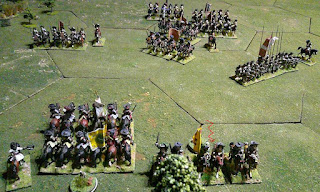My apologies for no July posts. Life and climate got in the way! In the case of the former, it was a sudden decision to move house, which meant being busy organising all that involves; in the case of the latter, it was the current heatwave which has hit our part of the UK.
To explain a little more, my fairly regular wargames opponent has been kind enough to lend me two trestles made for him by another wargamer, Paul, and which he has never used. As a result, it meant I could put up a board in the garage. Which I did. In fact I managed to set up an 11 feet by 4 feet table, an unheard of size in my long wargaming experience! And then the temperatures began to soar and the garage became uninhabitable for long periods of the day in the heat! Anyway, they dipped recently - though they are due to rise again soon - and so I had a go at a Sun King 1670s game.
I picked on Speyerbach 1703 as a starting point. I know it is from the War of the Spanish Succession, but the deployment is very like a late 17th Century battle, plus the two sides were fairly evenly-balanced. I decided to start the action at the point at which both sides were pretty much deployed, i.e. the early afternoon, rather than the initial contact and skirmishing. Nothing complex about the aims of each side, it is to beat the other in what is pretty much a stand-up fight, through the French got extra points for capturing the Allied camps and artillery battery, while the Allies get them for hanging on to them.
I was experimenting with the ECW rules from A. Taylor's very old wargame book from the 1970s (see my Nostalgia section). I have really liked the ACW ones, suitably tweaked, so I thought I would give the ECW set a go. They are "no dice" rules and written orders. I found I had to add a few dice rolls for a degree more realism, but otherwise I tried to keep faithful to the "no dice" spirit. The order writing was not trouble at all, even with this number of units, though whether it would go as smoothly with a lot of players is another matter! I set a five minutes maximum to fill in the sheets (see below) for each side; the symbols and abbreviations helped a lot.
The pictures are not quite as good as those in my normal venue - the dining room - where there is plenty of natural light. The garage is pretty much artificial light. So I need to work on my photography skills for future games! The squiggly blue and red arrows are to show the direction units are going in retreat/rout - it gets a bit confusing with similar coloured uniforms! The thick blue and red arrows show the direction of an attack.
Figures are almost all North Star 1672, flags mostly commercial, but with some homemade for the Dutch and Allies. The houses from Sarissa were all painted for me by Steve.
Anyway, here is the action. A French win in the end, although not entirely convincingly, with the Allied foot putting up a good fight, their right wing cavalry doing pretty well, and although their left wing cavalry collapsed, it was not an easy success for the French.
One of the order sheets. The game played for twelve turns - I set that as a limit. Arrows indicate direction of movement, fractions if less than full move, C = charge, FB = fall back and the number of moves, F = fire, H = halt, and so on. Quite simple and straightforward. Oh, the top of the sheet is presumed to be the opposite side of the table!







































































































No comments:
Post a Comment